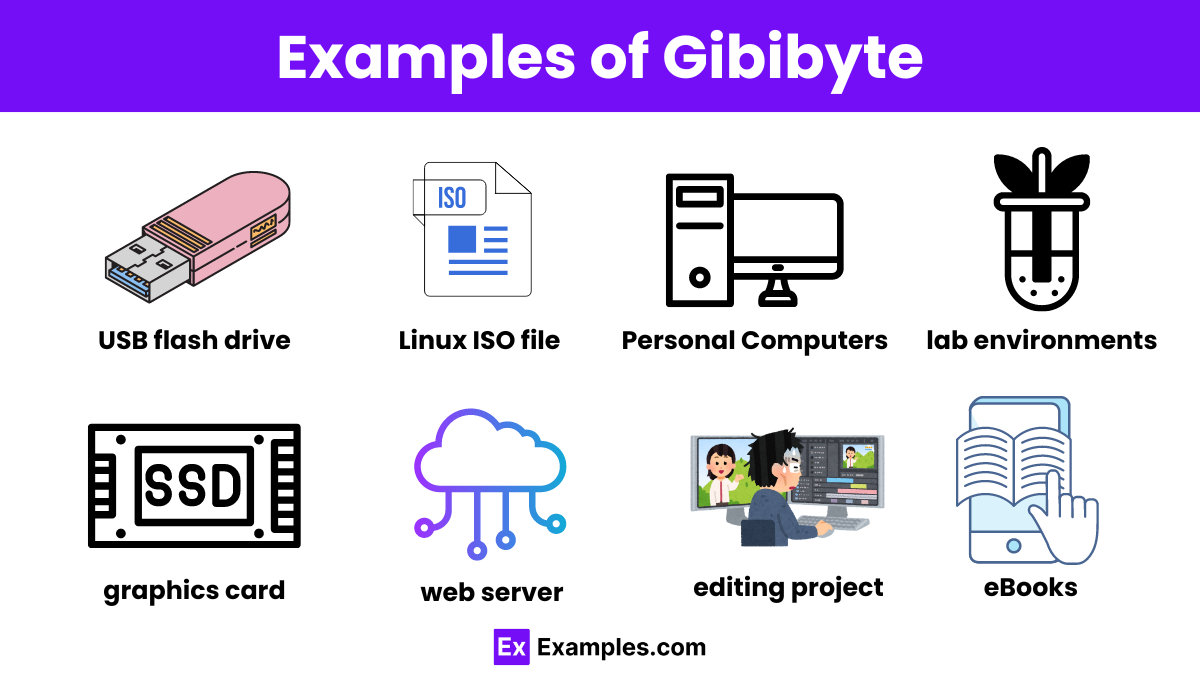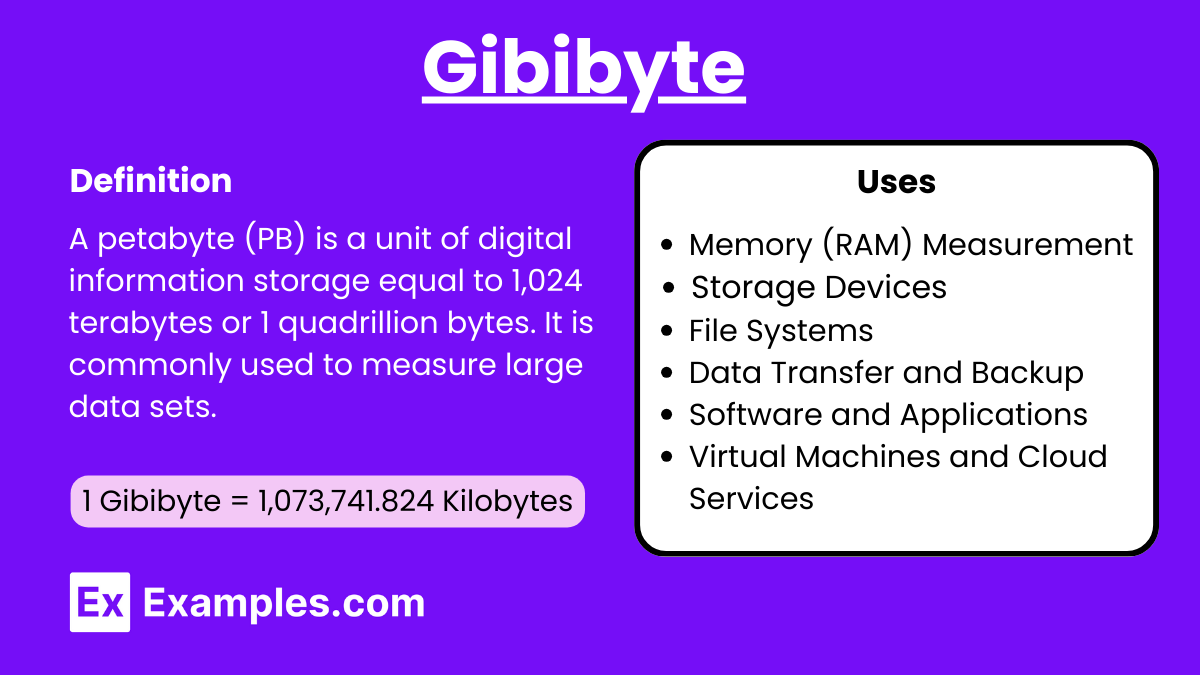Gibibyte – 40 Examples, Uses, Applications, Differences
A gibibyte (GiB) is a unit of digital information storage that equals 1,024 mebibytes or 1,073,741,824 bytes. It is commonly used in cloud computing to describe data storage capacities and in digital communication to measure data transfer sizes. As communication technology advances, understanding units like gibibytes becomes crucial for managing and optimizing data efficiently. The precise measurement of gibibytes ensures accuracy in data storage and transmission, enhancing overall system performance.
What is Gibibyte?
A Gibibyte (GiB) is a unit of digital information storage equal to 2^30 (1,073,741,824) bytes, often used to measure computer memory and storage capacities. It is part of the binary system of units, which is based on powers of two.
Examples of Gibibyte

- Storage capacity of a USB flash drive
- Size of a Linux ISO file
- Capacity of a smartphone’s internal storage
- Memory in a high-end graphics card
- RAM in a gaming laptop
- Size of a Windows installation
- Data on a single-layer Blu-ray disc
- Capacity of a standard SSD
- Space required for a high-resolution video game
- Backup size for a small database
- Storage needed for 4K video files
- Size of a large software suite
- Virtual machine disk size
- Digital library of eBooks
- Collection of high-quality MP3 files
- Space used by a photo editing software
- Storage for virtual reality content
- Backup for personal documents and media
- Data required for machine learning models
- Size of a scientific dataset
- Capacity of a music production project
- Storage for a CAD design project
- Space needed for mobile apps
- Data used by a web server
- Storage for high-resolution image files
- Capacity for an email server
- Data stored in cloud services
- Backup size for a home computer
- Storage for a video editing project
- Capacity needed for game development files
- Space for virtual lab environments
- Data in a content management system
- Capacity of a mid-range external hard drive
- Storage for IoT device data
- Backup size for an enterprise server
- Space used by a multimedia server
- Storage needed for a development environment
- Data stored in a blockchain node
- Size of a compressed video archive
- Capacity for a photo and video collection
How big is a Gibibyte?
1 GiB = 1,073,741,824 bytes
1 GiB ≈ 1.074 gigabytes (GB), where 1 GB = 1,000,000,000 bytes
What are Gibibyte used for?
1. Memory (RAM) Measurement
- RAM: Gibibytes are often used to measure the capacity of computer memory (RAM). For example, a computer might have 8 GiB or 16 GiB of RAM, which indicates the amount of data the memory can handle.
2. Storage Devices
- Hard Drives and SSDs: Gibibytes are used to denote the capacity of storage devices like hard drives and solid-state drives (SSDs). For instance, a 512 GiB SSD indicates the storage space available for storing files, applications, and the operating system.
- USB Drives: Flash drives and other portable storage devices often use Gibibytes to describe their storage capacity, such as a 32 GiB USB drive.
3. File Systems
- File Allocation: File systems use Gibibytes to manage and allocate space. When formatting a drive or partitioning a disk, the available space might be shown in GiB to provide a clear understanding of the storage capacity.
4. Data Transfer and Backup
- Backup Storage: Backup solutions, whether cloud-based or local, use Gibibytes to indicate storage limits. For example, a cloud backup service might offer 50 GiB of storage for data backups.
- Data Transfer: Gibibytes can also be used to measure the amount of data being transferred over networks or between devices. For instance, transferring 10 GiB of data from one computer to another.
5. Virtual Machines and Cloud Services
- Virtual Machines (VMs): When setting up virtual machines, the allocated memory and storage are often measured in Gibibytes. A virtual machine might be configured with 4 GiB of RAM and 50 GiB of virtual disk space.
- Cloud Services: Cloud providers like AWS, Azure, and Google Cloud use Gibibytes to describe the storage and memory capacities of their services. For example, a cloud instance might offer 16 GiB of RAM and 200 GiB of storage.
6. Software and Applications
- Database Systems: Databases use Gibibytes to measure data storage and memory usage. For example, a database system might require 100 GiB of storage to handle its data sets.
- Large Files: Applications that handle large files, such as video editing software or scientific simulations, often measure file sizes in Gibibytes. A high-definition movie file might be several GiB in size.
Other Units of Gibibyte
| Unit | Symbol | Bytes | Conversion |
|---|---|---|---|
| Bit | b | – | 1 b = 0.125 B |
| Byte | B | 1 | 1 B = 8 b |
| Kibibyte | KiB | 1,024 | 1 KiB = 1,024 B |
| Mebibyte | MiB | 1,048,576 | 1 MiB = 1,024 KiB |
| Gibibyte | GiB | 1,073,741,824 | 1 GiB = 1,024 MiB |
| Tebibyte | TiB | 1,099,511,627,776 | 1 TiB = 1,024 GiB |
| Pebibyte | PiB | 1,125,899,906,842,624 | 1 PiB = 1,024 TiB |
| Exbibyte | EiB | 1,152,921,504,606,846,976 | 1 EiB = 1,024 PiB |
| Zebibyte | ZiB | 1,180,591,620,717,411,303,424 | 1 ZiB = 1,024 EiB |
| Yobibyte | YiB | 1,208,925,819,614,629,174,706,176 | 1 YiB = 1,024 ZiB |
Applications of Gibibyte in Data Storage
1. Personal Computing
- Internal Storage: Many computers and laptops use storage measured in gibibytes, especially older models or budget devices. For instance, a computer with a 256 GiB solid-state drive (SSD) can store the operating system, applications, and user data.
- USB Flash Drives: Commonly available in sizes ranging from 4 GiB to 128 GiB, these portable devices are used for transferring files between computers and for backup purposes.
2. Mobile Devices
- Smartphones and Tablets: Devices typically come with storage capacities measured in gibibytes, such as 32 GiB, 64 GiB, or 128 GiB, to store apps, photos, videos, and other user data.
- MicroSD Cards: Used to expand storage in smartphones, cameras, and other portable devices, these cards are available in capacities like 32 GiB and 64 GiB.
3. Software and Applications
- Operating Systems: Operating systems like Windows, macOS, and Linux distributions often require several gibibytes of storage for installation. For example, Windows 10 requires around 20 GiB of storage space.
- Applications: Software applications, including productivity suites, games, and multimedia programs, often need several gibibytes of storage. For instance, Microsoft Office and Adobe Creative Suite can each occupy multiple gibibytes.
4. Gaming
- Game Storage: Many video games, especially those with high-resolution graphics and extensive content, require several gibibytes of storage. A typical modern game might require anywhere from 10 GiB to 100 GiB or more.
- Game Consoles: Gaming consoles like the PlayStation 4 and Xbox One offer storage capacities in gibibytes, such as 500 GiB or 1,024 GiB (1 TiB), to store games and downloadable content (DLC).
5. Multimedia Storage
- Photos and Videos: Digital photos and videos, especially those in high resolution, can take up several gibibytes of storage. For example, a collection of 1,000 high-resolution photos might occupy around 4-8 GiB.
- Music Libraries: Storing music files, whether they are in MP3, FLAC, or other formats, can require several gibibytes. A music library of 1,000 songs might need around 5-10 GiB.
6. Cloud Storage
- Service Plans: Many cloud storage services offer plans with capacities measured in gibibytes, such as 15 GiB free on Google Drive or 5 GiB free on iCloud. Paid plans often provide more storage, ranging from 100 GiB to several terabytes (TiB).
- Backup and Sync: Cloud services use gibibyte-level storage for backing up and syncing files across multiple devices.
7. Embedded Systems
- IoT Devices: Internet of Things (IoT) devices, such as smart home devices and industrial sensors, often use storage measured in gibibytes for firmware, application data, and logs.
- Automotive Systems: Modern cars use onboard computers with storage capacities in gibibytes to run navigation systems, entertainment systems, and vehicle diagnostics.
8. Educational Tools
- E-books and Courseware: Digital textbooks, e-books, and educational courseware often require several gibibytes of storage, especially when they include multimedia content.
- Online Learning Platforms: Platforms like Coursera, Khan Academy, and others store video lectures, interactive content, and user data, often in gibibyte quantities.
What is the Difference Between Gibibyte and Gigabyte
| Aspect | Gibibyte (GiB) | Gigabyte (GB) |
|---|---|---|
| Definition | A binary unit of digital information storage. | A decimal unit of digital information storage. |
| Bytes | 1 GiB = 1,073,741,824 bytes (2^30 bytes) | 1 GB = 1,000,000,000 bytes (10^9 bytes) |
| Measurement System | Binary (base-2) | Decimal (base-10) |
| Common Use | Used in computing, operating systems, and memory. | Used in marketing consumer electronics and storage devices. |
| Relation to Mebibytes/Megabytes | 1 GiB = 1,024 MiB (Mebibytes) | 1 GB = 1,000 MB (Megabytes) |
| Usage Example | RAM and disk storage capacities in computers. | Storage capacity of hard drives, SSDs, and USB drives. |
| Accuracy | More accurate for computing purposes. | Easier for consumer understanding and marketing. |
| Prefix Origin | Derived from binary prefixes (IEC standard). | Derived from SI prefixes (metric system). |
How does a gibibyte compare to a gigabyte?
A gibibyte is slightly larger than a gigabyte, holding 1,024 mebibytes compared to 1,000 megabytes.
Where are gibibytes commonly used?
Gibibytes provide a more precise measurement in computing, avoiding confusion with metric-based gigabytes.
How is a gibibyte different from a gibibit?
A gibibyte is 1,024 mebibytes, while a gibibit is 1,024 mebibits, focusing on data storage.
Can gibibytes be used in electromagnetism research?
Yes, electromagnetism research often requires precise data storage, making gibibytes useful.
What is the relationship between gibibytes and PaaS?
In PaaS (Platform as a Service), gibibytes measure data storage for applications and services.
How many bytes are in a gibibyte?
A gibibyte contains 1,073,741,824 bytes, providing a precise digital storage unit.
Are gibibytes used in cloud storage?
Yes, cloud storage providers use gibibytes to allocate and manage data storage.
Do operating systems use gibibytes?
Operating systems often use gibibytes to measure RAM and disk space accurately.
How do gibibytes benefit data storage?
Gibibytes offer precise data measurement, crucial for accurate data storage and management.
Is a gibibyte larger than a terabyte?
No, a gibibyte is smaller than a terabyte; 1 TB equals 1,024 gibibytes.


